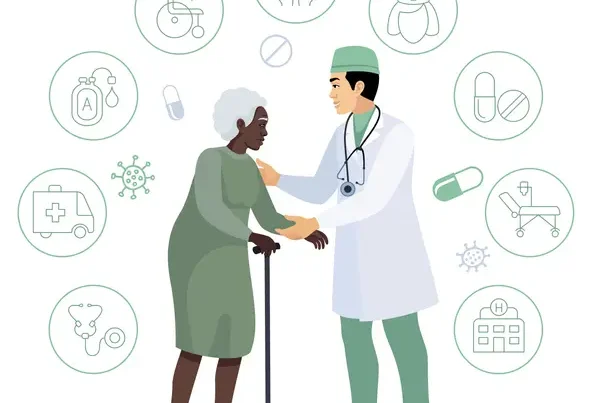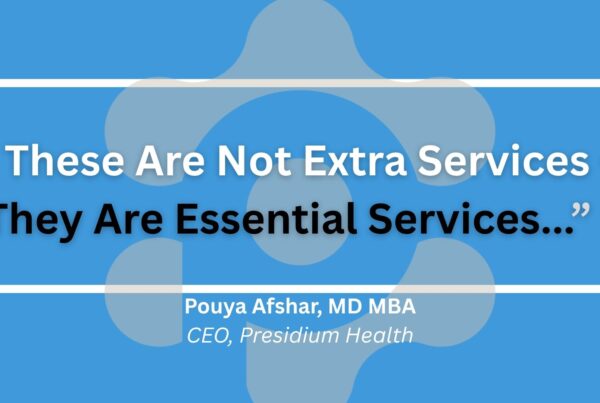Imagine a system that integrates healthcare with the support systems you rely on daily. That’s what CalAIM is all about. Short for “California Advancing and Innovating Medi-Cal,” this program reshapes Medi-Cal to offer more personalized, holistic care. It focuses on addressing not just medical issues, but also the social drivers of health. Designed to benefit underserved patients, it aims to create a more equitable and efficient healthcare delivery system for Californians. To learn more about this program check out our primary ECM resource.
What is CalAIM?
Think of CalAIM as California’s roadmap to overhauling its Medi-Cal program, aiming for seamless integration between health care services and social care. The initiative takes a whole person care approach to healthcare, addressing both physical and social needs to improve quality outcomes.
Purpose of CalAIM

At its core, CalAIM, is designed with clear goals in mind:
-
- Health Equity: Minimize health disparities, from urban centers to rural communities, with equal access to care.
- Holistic Care: Address not just medical needs but also social factors like housing and food insecurity.
- Efficiency: Reduce hospitalizations and healthcare costs by offering preventative, community-based solutions.
A primary goal is to shift the healthcare focus from reactive treatments to proactive support systems. This can make a real difference in the quality of life for Medi-Cal patients, particularly those managing chronic conditions or facing economic challenges. There are a multitude of case studies linking ECM success to CalAIM and improved outcomes.
Overview of Medi-Cal Integration
Here’s how CalAIM fits into Medi-Cal:
-
- Enhanced Care Coordination: Medi-Cal beneficiaries now benefit from care teams who monitor both health and social needs in a coordinated care initiative.
- Community Supports: Services like housing vouchers and meal programs are part of the care package.
- Simplification: Statewide standardization of programs to reduce confusion and ensure consistency for patients.
This integration isn’t just about health conditions. It’s about recognizing social struggles and tackling hurdles before they become crises. For more details about the long-term vision, consider reading this chcf article, which breaks down the changes in patient care.
It’s not reinventing healthcare; it’s refining and expanding what Medi-Cal already offers. The member benefits are enhanced through CalAIM and ECM by bridging medical and social services, a safety net that genuinely works for all Californians is established.
Key Features
CalAIM was established with a purpose to ensure that patients receive holistic, equitable care that addresses both their medical needs and daily challenges. Below are the primary features making it a game-changer in how healthcare services are delivered.
Enhanced Care Management (ECM)
At the heart of CalAIM lies Enhanced Care Management, designed to coordinate care for those with the most complex medical and social needs. ECM connects patients to a dedicated care team that tackles not just healthcare, but also related services like transportation, housing, and mental health support.
What is Enhanced Care Management?
Imagine you’re managing multiple chronic conditions while struggling with homelessness. ECM ensures you have one point of contact—a care manager—who coordinates your medical treatments, arranges social support services, and follows up to keep you on track. This personalized, hands-on approach greatly improves outcomes by reducing unnecessary hospital visits and improving care quality.
California’s Whole-Person Care Approach
Its Whole-Person Care (WPC) model approach shifts focus from just treating illnesses to addressing the complete array of patient needs—physical, emotional, and social. This initiative acknowledges that health doesn’t exist in isolation. Factors like housing, food security, and mental health are deeply intertwined with overall wellbeing.
Under WPC, Medi-Cal supports services like:
-
- Housing Assistance: Helping unhoused individuals find stable accommodations.
- Meal Programs: Offering nutritional support for those in need.
- Behavioral Health Services: Supporting mental health and substance use recovery.
By addressing these interconnected needs, patients receive care that truly improves their quality of life.
Focus on Social Determinants of Health

Social Determinants of Health (SDOH)—the conditions in which people are born, grow, live, work, and age—play a crucial role in CalAIM. The program doesn’t stop at medical care; it actively works to minimize barriers that affect patient health outcomes.
How does it address social determinants? By prioritizing services like:
-
- Transportation Assistance: Ensuring patients can attend medical appointments.
- Nutritional Support: Connecting those facing food insecurity with sustainable food resources.
- Community-Based Services: Offering localized programs targeted to specific community needs.
A focus on SDOH transforms healthcare from a quick fix to a sustained improvement in quality of life. Curious about why social factors are essential? Check out this information article for further insights.
By considering everything affecting patient health—not just illness— this infrastructure is is paving the way for a more inclusive and effective approach to care.
Expanded Dental Benefits
Features include expanded pay for performance patents for preventative services, a carries risk assessment bundle for young children and silver diamine fluoride for young children. Read the dhcs article on this initiative for more information.
Services For Justice Involved Youths and Adults
Historically this population is disproportionately at risk for poor health outcomes secondary to socioeconomic barriers. This addresses the transitional period at which time this cohort becomes reintroduced to their communities. Read more about this re-entry initiative on dhcs website.
Benefits for Patients
CalAIM, is more than a healthcare initiative—it’s a lifeline for Medi-Cal patients seeking comprehensive care that goes beyond the clinic. By addressing medical and social needs simultaneously, this program delivers a more personalized and equitable health experience. Here’s how CalAIM benefits patients directly.
Improved Access to Services
CalAIM revolutionizes access for Medi-Cal patients, breaking down barriers that often prevent timely care. Medi-Cal enrollees now gain streamlined support through expanded benefits.
-
- Patients can access housing-focused services to secure stable living environments, critical for overall health.
- Those with mobility challenges have access to transportation support for medical appointments.
- Nutritional programs provide sustainable food assistance for individuals facing food scarcity.
By focusing on accessibility, CalAIM ensures that healthcare services are no longer out of reach for those who need them most. For a detailed look into how this program expands healthcare options, explore the official guide.
Coordinated Care
One of the standout benefits of CalAIM is its emphasis on care coordination. Managing multiple health issues or navigating complex healthcare systems can overwhelm patients. CalAIM addresses this by assigning care managers who act as the patient’s advocate and organizer.
-
- Imagine having one person coordinate your doctor visits, prescription refills, and mental health support. That’s the power of care management.
- Care teams collaborate to ensure medical treatments and social services seamlessly integrate.
- Patients spend less time figuring out the system and more time focusing on recovery and wellness.
This coordinated approach improves not just outcomes but also the experience of receiving care. Learn more about the structure of CalAIM’s care coordination efforts here.
CalAIM isn’t just about tweaking how Medi-Cal operates; it’s about removing the stress and confusion around healthcare. By prioritizing both access and coordination, it ensures patients get the right care at the right time, every time.
Presidium Health and CalAIM

Presidium Health actively supports CalAIM’s mission by providing holistic, patient-focused healthcare services designed for Medi-Cal beneficiaries. By addressing the social and medical needs of patients, Presidium Health ensures they align seamlessly with CalAIM’s goals of transforming healthcare delivery in California.
Role of Presidium Health in CalAIM
Presidium Health plays a critical role in implementing CalAIM by combining innovative care models and community-focused solutions. The organization specializes in addressing the needs of the most vulnerable populations, including patients with complex medical and social challenges.
Here’s how Presidium Health contributes:
-
- Enhanced Care Coordination: Their state-of-the-art care platform connects patients to the right resources at the right time. To learn more about their strategies, visit Navigating Challenges in Enhanced Care Management.
- Community-Based Solutions: Presidium focuses on integrating housing, food, and mental health support into their patient care plans. This matches CalAIM’s vision of tackling root issues that influence health.
- Technology Integration: By utilizing technology, Presidium Health ensures that underserved Medi-Cal recipients receive timely and personalized care. In alignment with CalAIM, they bridge the gap between healthcare and social services. You can read about their initiatives here.
Presidium’s comprehensive approach empowers patients and reduces strain on the healthcare system by focusing on preventive care and addressing social determinants.
Impact on Patient Care
Presidium Health’s approach directly aligns with CalAIM’s core objective of creating a more equitable healthcare system. By offering services that address the whole person, they go beyond traditional medical treatments to support overall wellbeing.
-
- Reducing Hospitalizations: Presidium emphasizes proactive care, which prevents costly hospital visits. This is especially critical for high-utilizer patients Medi-Cal targets.
- Addressing Social Needs: Presidium prioritizes housing assistance, behavioral health services, and nutrition programs. These services fall perfectly in line with CalAIM’s community supports framework.
- Improved Communication: With dedicated care teams, patients experience seamless coordination across medical and social services. This streamlined effort helps patients feel cared for and supported.
In addition, Presidium’s work has demonstrated cost-saving benefits for the healthcare system, aligning with CalAIM’s efficiency goals. For more on their expansion efforts, explore Presidium Expanding Cost-Saving Health Program Across State.
By aligning with CalAIM’s vision, Presidium Health exemplifies how patient-centered care not only improves lives but also sets a strong foundation for a healthier California.
Conclusion
CalAIM is more than a healthcare program—it’s a revolution in how Medi-Cal serves Californians. By focusing on a whole-person approach, improving care coordination, and addressing social determinants of health, it creates a system that treats people, not just medical conditions. While this service is early stages, it is essential to understand why protecting CalAIM ensures ECM’s future. For those navigating healthcare challenges, this program is designed to make life easier while fostering better health outcomes.
If you want to dive deeper into how CalAIM is shaping patient care, be sure to check out the official Guide and this insightful high-level summary. These links provide valuable insights into the program’s ongoing impact.




